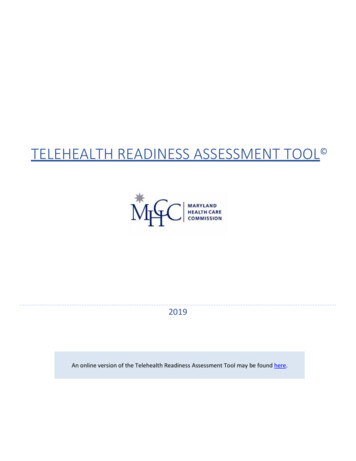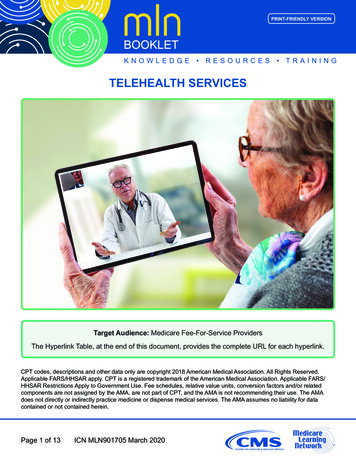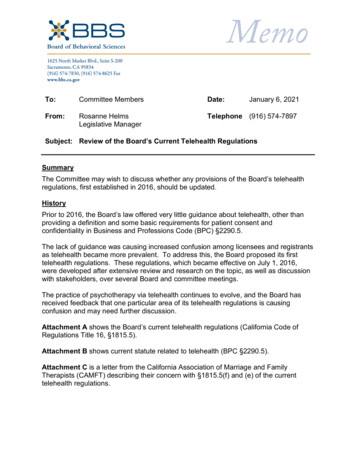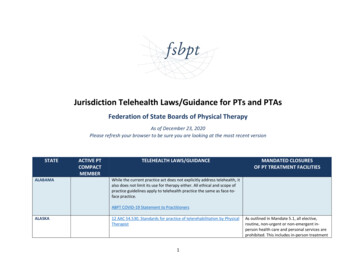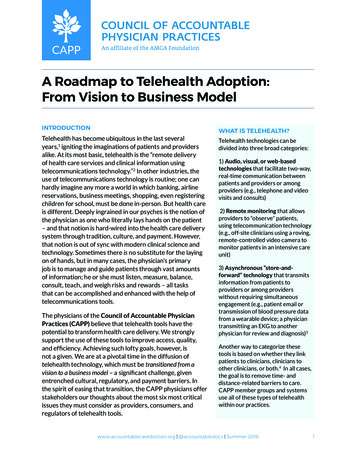
Transcription
CAPPA Roadmap to Telehealth Adoption:From Vision to Business ModelINTRODUCTIONTelehealth has become ubiquitous in the last severalyears,1 igniting the imaginations of patients and providersalike. At its most basic, telehealth is the “remote deliveryof health care services and clinical information usingtelecommunications technology.”2 In other industries, theuse of telecommunications technology is routine; one canhardly imagine any more a world in which banking, airlinereservations, business meetings, shopping, even registeringchildren for school, must be done in-person. But health careis different. Deeply ingrained in our psyches is the notion ofthe physician as one who literally lays hands on the patient– and that notion is hard-wired into the health care deliverysystem through tradition, culture, and payment. However,that notion is out of sync with modern clinical science andtechnology. Sometimes there is no substitute for the layingon of hands, but in many cases, the physician’s primaryjob is to manage and guide patients through vast amountsof information; he or she must listen, measure, balance,consult, teach, and weigh risks and rewards – all tasksthat can be accomplished and enhanced with the help oftelecommunications tools.The physicians of the Council of Accountable PhysicianPractices (CAPP) believe that telehealth tools have thepotential to transform health care delivery. We stronglysupport the use of these tools to improve access, quality,and efficiency. Achieving such lofty goals, however, isnot a given. We are at a pivotal time in the diffusion oftelehealth technology, which must be transitioned from avision to a business model – a significant challenge, givenentrenched cultural, regulatory, and payment barriers. Inthe spirit of easing that transition, the CAPP physicians offerstakeholders our thoughts about the most six most criticalissues they must consider as providers, consumers, andregulators of telehealth tools.WHAT IS TELEHEALTH?Telehealth technologies can bedivided into three broad categories:1) Audio, visual, or web-basedtechnologies that facilitate two-way,real-time communication betweenpatients and providers or amongproviders (e.g., telephone and videovisits and consults)2) Remote monitoring that allowsproviders to “observe” patients,using telecommunication technology(e.g., off-site clinicians using a roving,remote-controlled video camera tomonitor patients in an intensive careunit)3) Asynchronous “store-andforward” technology that transmitsinformation from patients toproviders or among providerswithout requiring simultaneousengagement (e.g., patient email ortransmission of blood pressure datafrom a wearable device; a physiciantransmitting an EKG to anotherphysician for review and diagnosis)3Another way to categorize thesetools is based on whether they linkpatients to clinicians, clinicians toother clinicians, or both.4 In all cases,the goal is to remove time- anddistance-related barriers to care.CAPP member groups and systemsuse all of these types of telehealthwithin our practices.www.accountablecaredoctors.org @accountabledocs Summer 20181
SIX CRITICAL TELEHEALTH CONCEPTS FOR STAKEHOLDER CONSIDERATIONThe health care delivery system is still in the early stages of telehealth diffusion. Stakeholders’decisions and actions in each of these areas will determine whether telehealth transforms caredelivery, or simply “electrifies” old and inefficient ways of doing business.1. Telehealth must integrate, not fragment, careTelehealth tools can be categorized based on whether they are an integral part of a given clinicalpractice or “layered on top” as a freestanding service. In some cases, CAPP groups and systemshave developed (or purchased) their own telehealth capabilities, which enable expanded accessto their own providers or to providers with whom they have contracted. Use of such tools maybe a covered benefit for insured patients or may be sold “a la carte” to patients whose insurancedoes not cover it. In other cases, the patients of CAPP member groups may be offered (by theiremployers or insurers) access to freestanding telehealth vendors that are unrelated to the practicefrom which they receive routine care. These freestanding vendors typically provide only urgentcare but may also engage in primary or behavioral health care. These two models are not equallybeneficial for patients; the former integrates care, while the latter fragments it.We believe telehealth tools are most effective when they are used in the context of an alreadyestablished relationship between a patient and an accountable health care delivery system. Likein-person visits, telehealth encounters with a patient’s own provider or system are simply anothermeans of delivering integrated, comprehensive care – another touchpoint for patients to connectwith their medical “home.”We are concerned by the proliferation of third-party, national telehealth companies that manyemployers offer as a freestanding benefit to their employees. In many cases, such third-partytelehealth vendors do not have access to patients’ medical and pharmaceutical records, are unableto consult with patients’ regular physicians, and may be unfamiliar with local resources (a seriousproblem if the remote clinicians are advising patients about whether and where to seek in-personcare). Further, it is rare for third-party telehealth providers to share information about patientencounters with patients’ regular physicians, making follow-up and coordination impossible.Quality is frequently sub-optimal when there is such a disconnect between telehealth providersand patients’ established providers. For example, without accountability to a patient’s regularproviders or an ongoing relationship with the patient, we have found that contracted third-partyproviders are often biased towards patient-pleasing quick fixes, such as antibiotic or steroidprescriptions for conditions that don’t require such medications.When payers offer employees or plan members improperly-incentivized telehealth access fromthird-party companies, they disrupt the relationship between those members and their regularsource of care. Such a move is contrary to the push for “value-based payment” – a model westrongly support5 – under which payers hold providers financially responsible for meeting avariety of cost and quality targets for groups of patients. It is understandable that employers wantto recruit and retain talented employees by offering them 24/7 access to telehealth services.However, a more effective strategy to achieve that same end would be to support employees’own physicians and groups – primarily through plan design and payment policy – in developing ordeploying their own telehealth capabilities (as described in item #3 below).www.accountablecaredoctors.org @accountabledocs Summer 20182
2. Telehealth improves quality, access, and convenience; cost-savings are not paramount.While critics and supporters of telehealth alike may call attention to its cost-saving (or some maysay “cost cutting”) potential, short-term savings for payers are not the most salient feature ofthese tools. In fact, in the experience of most CAPP member health systems, telehealth visits (viaphone or video) do not replace but rather augment in-person use of care. We would expect anycost savings to payers to accrue primarily in the longer run, as telehealth tools expand access topreventive care and disease management, eliminating the need for more costly interventions downthe road. From the perspective of an employer or insurer that will likely no longer be responsiblefor a given patient by the time such savings materialize, this cost-saving aspect of telehealth isnot compelling. Much more compelling is the notion that telehealth tools can improve access andquality while making care more convenient for patients.Telephone and video visits, as well as asynchronous messaging between providers and patients,can be used safely to provide care to many patients. Not only do these tools improve access to carefor patients who use them, but they also free up in-person visits for patients whose conditionsrequire them (or who simply prefer them). Because information and advice are readily available,telehealth-supported visits may also help reduce unnecessary emergency room or urgent visits,which not only improves access in those settings but may also improve quality. Telehealth tools canalso be used during in-person visits to improve access to follow-up or specialist care. Consider theinstance in which a primary care provider and patient together consult via phone or video with aspecialist in real-time, during the primary care visit. Such arrangements give the patient immediateaccess to the specialist with zero wait time, and virtually eliminate the possibility that the patientwill not follow through (for any number of reasons) with a recommended specialist visit. In suchsituations, access and quality are improved.Telehealth tools can also vastly improve quality of care by getting the right care to the patientin the right setting, quickly. This is particularly true of tools that link clinicians to one another.For example, under telestroke programs, used by many of the CAPP groups, emergency roomphysicians in hospitals without in-house stroke neurology units can connect with a remoteneurologist, often before the suspected stroke patient arrives via ambulance to the emergencydepartment.6 The remote neurologist can access diagnostic images and begin the patient’sassessment immediately, which is particularly critical in stroke care, where treatment is moreeffective the sooner it begins and seconds matter. At Kaiser Permanente, the use of a life-savingtissue plasminogen activator (tPA) treatment for patients with acute ischemic stroke increasedby 73 percent following the implementation of a telestroke program.7 Similar quality gains maybe expected through the use of telehealth tools to support clinicians in other settings wherea specialist cannot be physically present at all times – such as eICU programs, e-psychiatryconsults in emergency departments, and remote clinician services provided to patients in skillednursing facilities.Finally, while the jury is still out on telehealth’s long-term cost-savings for payers and healthsystems, it can clearly be cost-saving for patients, in terms of the opportunity costs of missingschool and work, and the associated stress and hassle. While it is easy to understand that distanceand time are barriers to care in rural areas, the same is often true in urban areas as well, wherepublic transportation challenges and congestion can make getting to the doctor inordinately timeconsuming. In short, it is not just rural people who are inconvenienced by going to the doctor. Towww.accountablecaredoctors.org @accountabledocs Summer 20183
the extent that the use of telehealth reduces that inconvenience and causes patients to seek caresooner or more regularly and adhere to prescribed therapies, quality and access are also improved.3. Fee-for-service payment policies are often the primary barrier to optimal, widespread use oftelehealth technology.As noted previously, telehealth technology can be used most effectively, efficiently, and safelyin an existing, coordinated care environment where the patient is known. As payers increasinglydemand better value in health care, it makes little sense for them to support freestanding, thirdparty telehealth vendors whose physicians are not engaged with patients’ regular providers.Instead, payers must use their resources to incentivize accountable medical groups and healthsystems to develop and deploy these tools. They can do this by liberalizing the rules under whichthey reimburse for telehealth using fee-for-service (FFS) arrangements, and by expanding the useof capitation, bundling, and other risk-sharing arrangements.Many of the CAPP groups receive at least some reimbursement via capitation or other risk-bearingmodels. Under such arrangements, providers are in fact incentivized to implement telehealthtechnologies – and other innovations that enhance value. However, for many provider groups andsystems, particularly smaller ones, capitated patients do not make up a large enough proportionof the patient population to allow for investment in these expensive capabilities. For these groups,and for the majority of physicians in the U.S., FFS payment still rules the day, and FFS policiesregarding telehealth are far too restrictive to result in the optimal and widespread use of thesetools across the delivery system.Many FFS payers follow the lead of Medicare in establishing telehealth payment rules. Perhapsthe most problematic aspect of Medicare’s rules is that payment is restricted to services when theoriginating site (where the patient is located) is outside of a metropolitan statistical area or withina designated rural health professional shortage area.8 There are significant access, quality, andconvenience benefits to telehealth that should also be available to people in urban areas. Medicarealso requires that the originating site must be one of several types of clinical settings and cannot bethe patient’s home. Finally, the only types of providers that can receive payment for providing carevia telehealth are physicians, advanced practice nurses, physician assistants, clinical psychologists,clinical social workers, and registered dietitians. Many other types of providers – includingpharmacists, speech and language pathologists, and occupational therapists – could also delivercare effectively via telehealth but cannot be reimbursed under Medicare for doing so. To its credit,Medicare has recently signaled its intent to loosen some of the telehealth payment restrictions inrural areas9 and to ease some provider billing challenges,10 but it is not yet clear what impact thechanges will have.In addition to being restrictive, FFS payments for telehealth are often inadequate to coverproviders’ costs of delivering the service. Many payers pay less for telehealth care than for thesame care delivered in-person, assuming that providers’ costs are lower for the former. This maybe the case when telehealth care is delivered by a third-party vendor operating a phone bank ofdoctors, but it is not necessarily the case when care is delivered by providers who are an integralpart of a bricks-and-mortar practice. Many states have telehealth coverage parity laws, whichrequire insurers to cover telehealth in the same way that they cover in-person visits, but such rulesrarely require parity of payment.11www.accountablecaredoctors.org @accountabledocs Summer 20184
When used appropriately, telehealth services are equally valuable as in–person services, and FFSpayments must reflect that value. The perception that telehealth is of lower value than face-to-facecare can also impact other policies that ultimately affect payment. For example, under MedicareAdvantage (where the restrictive Medicare FFS payment rules do not apply), diagnoses madeduring telehealth encounters cannot be used for calculating risk adjustment payments. Medicarealso does not include telehealth encounters in its patient satisfaction surveys – again, potentiallydiscounting its value and under-incentivizing providers to use it.4. Lack of uniformity in public and private regulatory structures also challenges the widespread useof telehealth.Even in a supportive payment environment, widespread deployment of telehealth can be stymiedby conflicting and sometimes outdated regulatory structures. A myriad of public and privateentities have a hand in determining which providers are allowed to give care to which patients inwhat locations. For example, to protect patient safety and ensure inpatient quality, state regulators,insurers, and accrediting organizations dictate procedures for hospital credentialing and privilegingof physicians. Such procedures must be updated to streamline privileging processes for remotephysicians – particularly in the rarer specialties – caring for patients who may be scattered acrossdozens of different hospitals. It is simply not feasible (nor cost efficient) for a single physician toundergo credentialing and privileging in dozens of locations. While accreditors and most payersdo permit or recognize some reciprocal credentialing among certain sites of care, each has itsown set of restrictions on such practices. This lack of standardization among payers places a highadministrative burden on providers.Lack of reciprocity in state medical licensing is also problematic for telehealth implementationwhen a provider system spans multiple states, or when patients travel frequently outsideof their “home” states – for example, in the case of “snowbirds” leaving the Midwestern andNortheastern states for the winter to live in Florida and other, warmer states. Currently, atelehealth provider must be licensed in the state in which the patient is located. Some states haveestablished reciprocal licensing agreements, but many have not.12 State licensing boards mustwork together to overcome this challenge to telehealth, either by expanding reciprocity to allfifty states, or by establishing limited reciprocity for the purpose of enabling telehealth in certain,defined circumstances.5. Patients need education about the value of telehealth tools and how to use them.The value of telehealth will not be realized if patients don’t want or don’t know how to use it. It isthe responsibility of providers to educate patients about the benefits of using telehealth to stayconnected to a practice with which they already have a relationship. In many of the CAPP groups,we have found that patients are more willing to try telehealth services when their own doctor orfamiliar clinic staff tell them about it.Patient education must include information about what can and cannot be accomplished withtelehealth. Patients should know that in different situations, telehealth care can either complementor substitute for in-person care, but in some cases, it can do neither. Exhibit 1 is an example asimple decision-making guide that can help patients decide which modality is right in any givensituation. Such decision-making tools are especially important when patients face very differentlevels of out of pocket cost-sharing for the different modalities.www.accountablecaredoctors.org @accountabledocs Summer 20185
to go to getog/2018/05/Patient education about telehealth should also address concerns regarding the technology. Onone hand, patients may not want to use email, telephone, or video visits because of concerns thatthey are not secure. Conversely, patients may not understand why they must use secure platformsfor these modalities, rather than just texting or video-chatting directly through existing apps ontheir phones.EXHIBIT 1: EXAMPLE OF A PATIENT TELEHEALTH DECISION GUIDEWhere to Get Care When You Need itTELEHEALTHSame or less thanoffice visit copay No appointment needed See a doctor 24/7 from yoursmartphone, tablet or computer. For colds, the flu, headaches, sprains,rashes, and other minor conditions. Available in most states if you’re traveling. Visit hap.amwell.com. Use service key HAPMi.URGENT CAREPRIMARYCARE PHYSICIANOffice visit copay Appointment needed See a doctor who knows you andyour medical history. For preventive and well care visits,routine care, vaccines, prenatal care,asthma control, and minor injuriesand illnesses. Find a doctor at hap.org.EMERGENCY ROOMUrgent care copay No appointment neededEmergency room copay No appointment needed See a doctor for nonemergency issues whenyour primary care physician can’t see you. See a doctor for life-threatening, traumatic,medical and surgical problems. For back or muscle pain, cuts, minorburns, earaches, sore throats, sprains,joint pain, upper respiratory infections,bronchitis, vomiting and diarrhea. Nationwide urgent carecoverage Find a facilityat hap.org
department.6 The remote neurologist can access diagnostic images and begin the patient’s assessment immediately, which is particularly critical in stroke care, where treatment is more effective the sooner it begins and seconds matter. At
